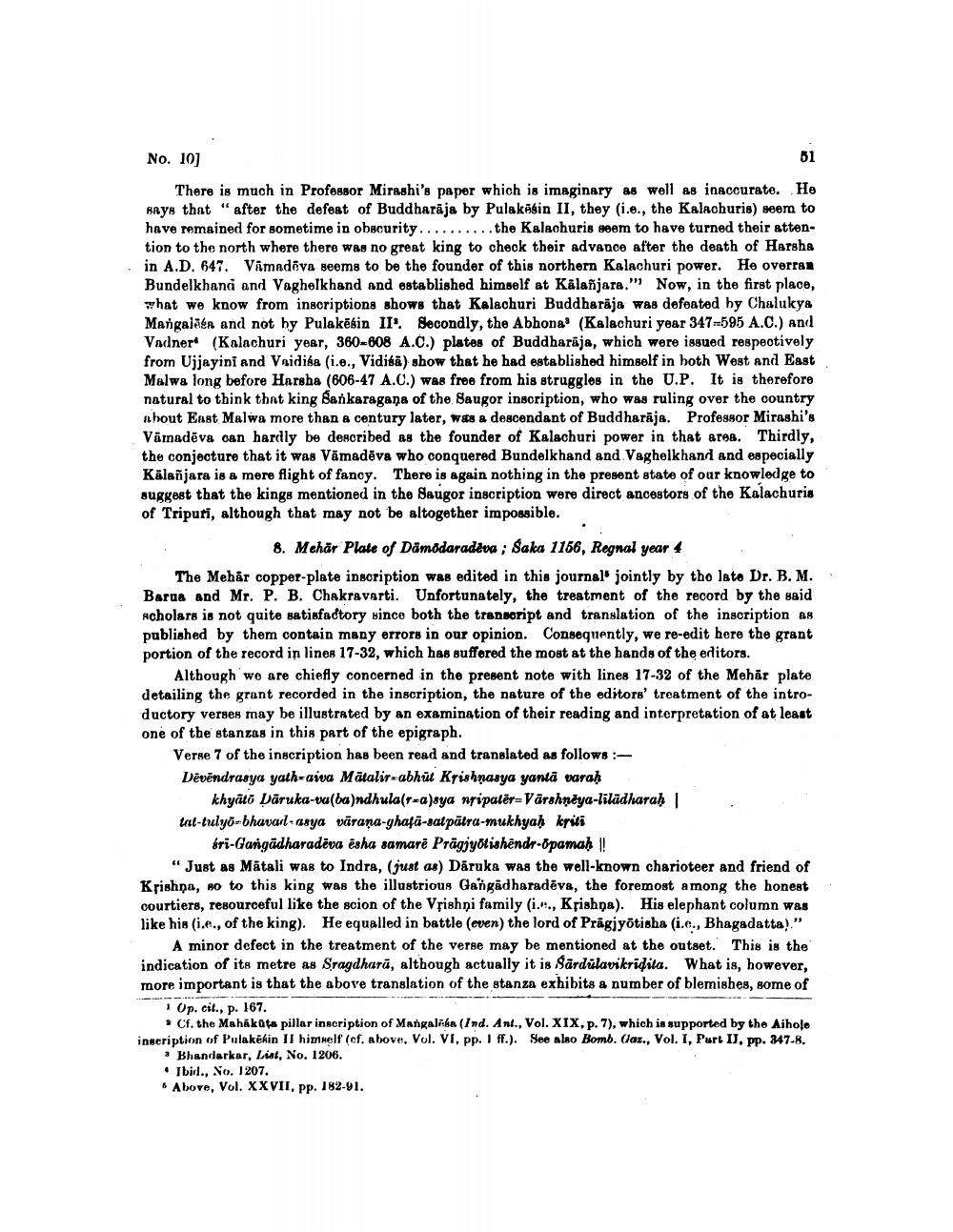________________
No. 10]
There is much in Professor Mirashi's paper which is imaginary as well as inaccurate. He Hays that "after the defeat of Buddharāja by Pulakāgin II, they (i.e., the Kalachuris) seem to have remained for sometime in obecurity.......... the Kalachuris seem to have turned their attention to the north where there was no great king to check their advance after the death of Harsha in A.D. 647. Vamadova seems to be the founder of this northern Kalachuri power. He overran Bundelkhand and Vaghelkhand and established himself at Kālañjara." Now, in the first place, what we know from inscriptions shows that Kalachuri Buddharaja was defeated by Chalukya Mangalien and not by Pulakëbin II. Secondly, the Abhona (Kalachuri year 347-595 A.C.) and Vndner (Kalachuri year, 360-608 A.C.) plates of Buddharāja, which were issued respeotively from Ujjayini and Vaidika (i.e., Vididā) show that he had established himself in both West and East Malwa long before Harsha (606-47 A.C.) was free from his struggles in the U.P. It is therefore natural to think that king Sankaragana of the Saugor inscription, who was ruling over the country shout East Malwa more than a century later, W88 a descendant of Buddharāja. Professor Mirashi's Vāmadēva can hardly be described as the founder of Kalachuri power in that area. Thirdly, the conjecture that it was Vámadēva who conquered Bundelkhand and Vaghelkhand and especially Kālañjara is a mere flight of fancy. There is again nothing in the present state of our knowledge to suggest that the kings mentioned in the Saugor inscription were direct ancestors of the Kalachuris of Tripuri, although that may not be altogether impossible.
8. Mehär Plate of Damodaradeva ; Saka 1156, Regnal year 4 The Mehár copper-plate inscription was edited in this journal' jointly by the late Dr. B.M. Baris and Mr. P. B. Chakravarti. Unfortunately, the treatment of the record by the said Acholars is not quite satisfactory since both the transcript and translation of the inscription 88 published by them contain many errors in our opinion. Consequently, we re-edit here the grant portion of the record in lines 17-32, which has suffered the most at the hands of the editors.
Although we are chiefly concerned in the present note with lines 17-32 of the Mehär plate detailing the grant recorded in the inscription, the nature of the editors' treatment of the introductory verses may be illustrated by an examination of their reading and interpretation of at least one of the stanzas in this part of the epigraph.
Verse 7 of the inscription has been read and translated as follows :Dēvēndrasya yath-aiva Mātalir-abhūt Krishnasya yantā varah
khyāto Däruka-valba)ndhula(r=a)sya ngipatēr=Värshneya-lilūdharah tat-tulyo-bhavarl-asya vārana-ghafā-satpätra-mukhyah kriti
bri-Gangadharadeva esha samarē Prāgjyotishëndr-Opamah ! “Just as Mātali was to Indra, (just as) Dáruka was the well-known charioteer and friend of Krishna, no to this king was the illustrious Gangadharadēva, the foremost among the honest courtiers, resourceful like the scion of the Vpishņi family (i..., Krishna). His elephant column was like his (ie., of the king). He equalled in battle (even) the lord of Pragjyotisha (i.e., Bhagadatta)."
A minor defect in the treatment of the verse may be mentioned at the outset. This is the indication of its metre as Sragdharā, although actually it is sārdülavikridita. What is, however, more important is that the above translation of the stanza exhibits a number of blemishes, some of
1 Op. cit., p. 167.
Cf. the Mahakata pillar inscription of Mangaliba (Ind. Ant., Vol. XIX, p. 7), which is supported by the Aihole inscription of Pulakekin II himself (cf. above, Vol. VI, pp. 1 ff.). See also Bomb. (lat., Vol. I, Part I). pp. 347-8.
3 Bhandarkar, List, No. 1206. • Ibid., No. 1207. Above, Vol. XXVII, pp. 182-91.




